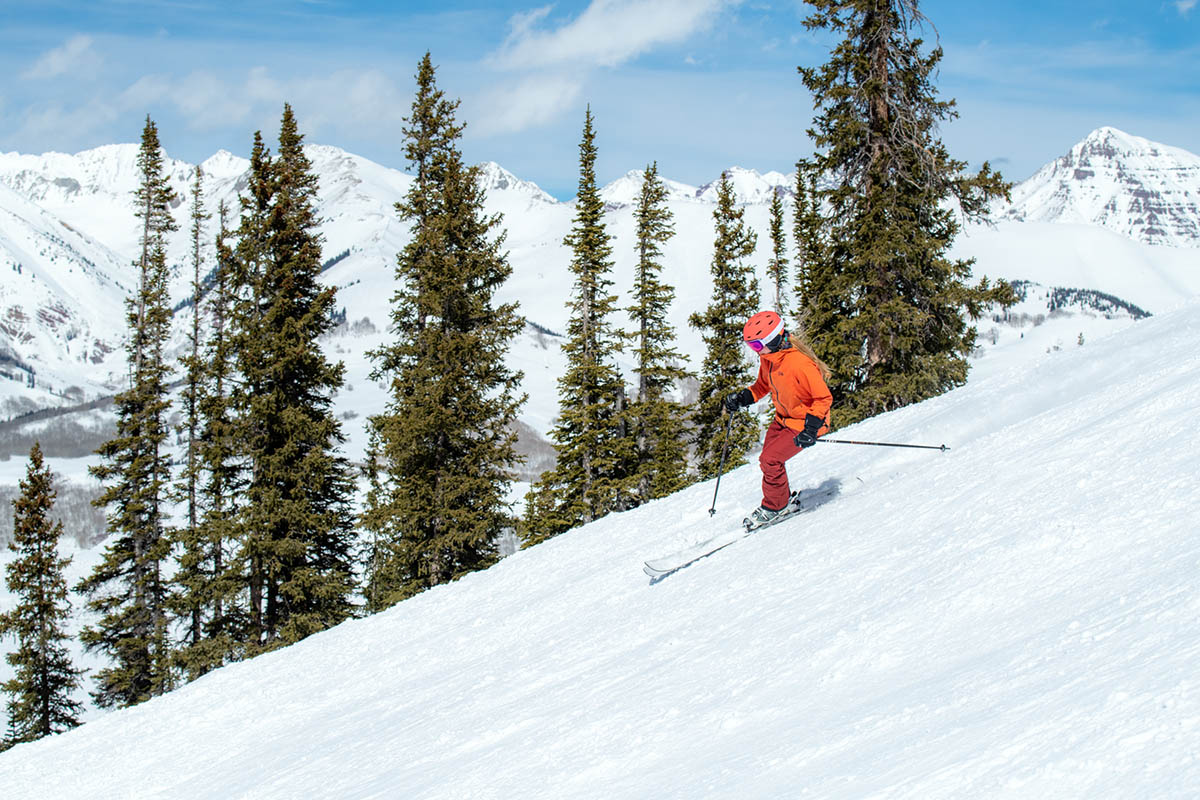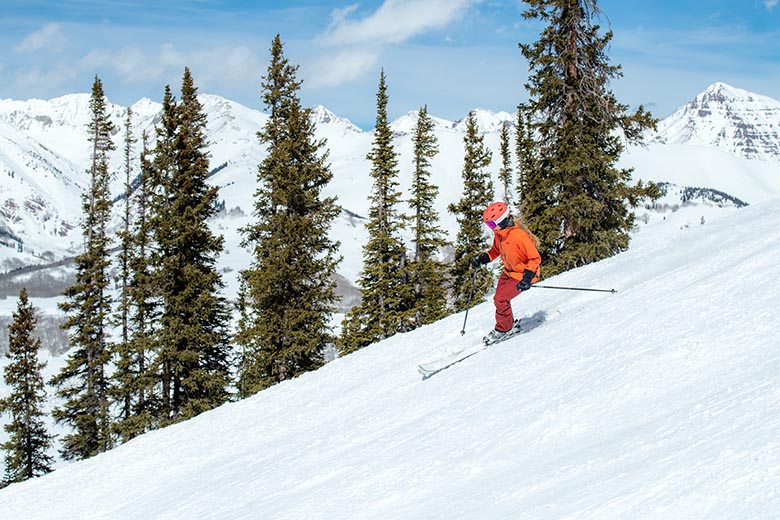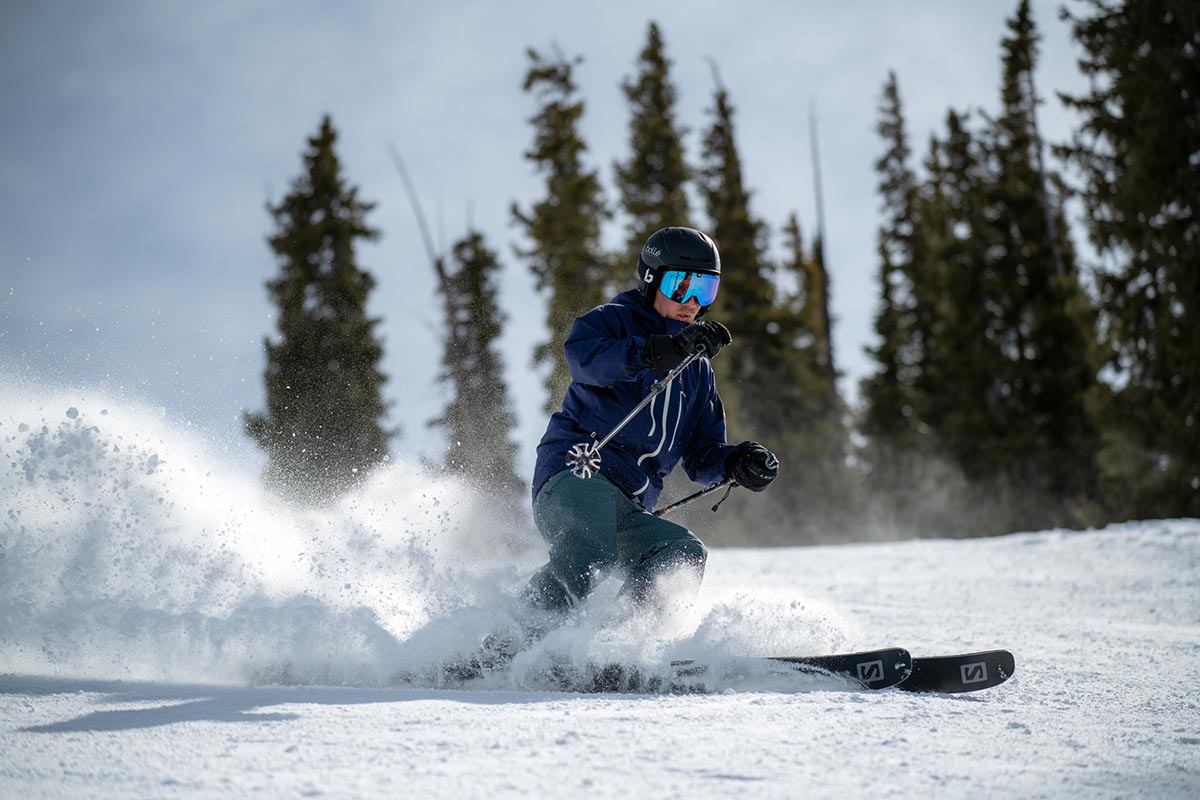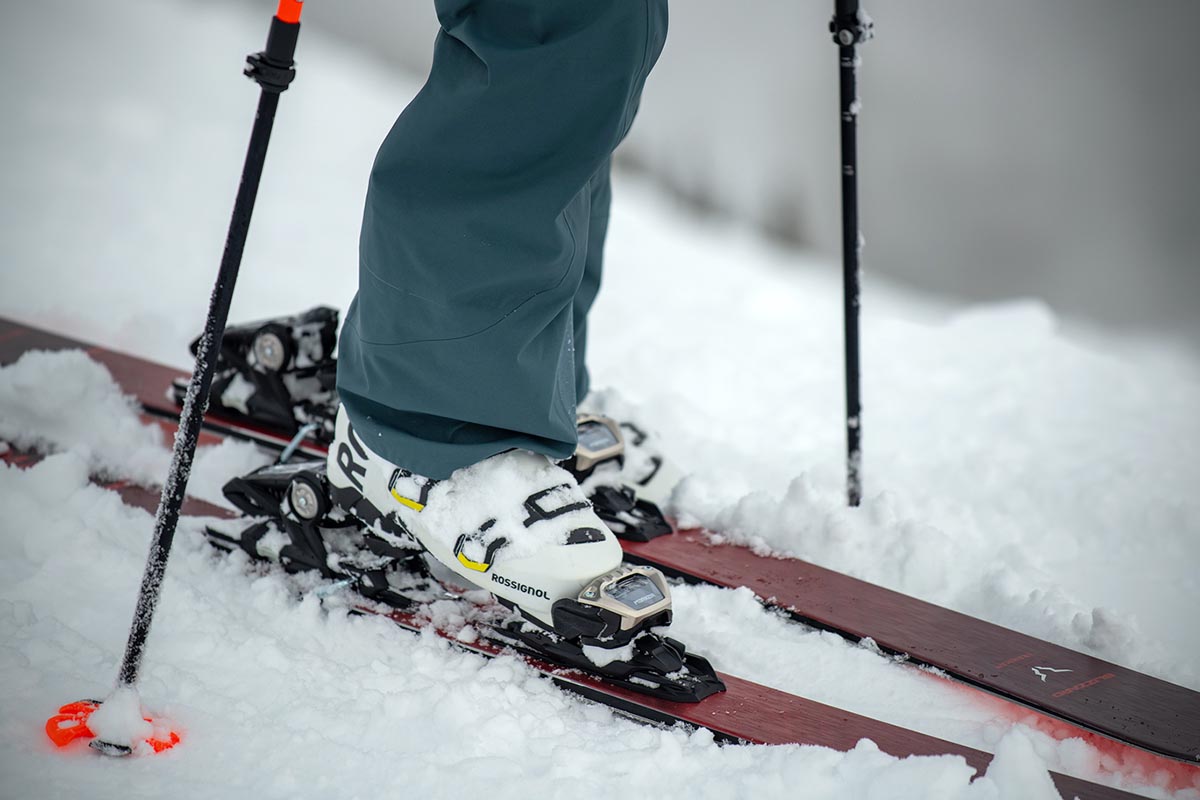

Picking an all-mountain ski can be a daunting task. The category covers a wide range of styles from groomer-oriented skis to more powder-friendly designs. In addition, the sheer number of models and turnover in the market further muddy the waters. To provide clarity for those on the hunt for a new pair of sticks, we’ve broken down the key steps in choosing an all-mountain ski, from snow conditions and waist width to understanding rocker, camber, and turn radius. For a look at our top picks, see our articles on the best all-mountain skis and best women's all-mountain skis.
Editor’s note: We updated this article on August 27, 2025 to swap most models to the latest 2025-2026 versions. We also swept the guide to ensure all information was current at the time of publishing.
A great way to start your all-mountain ski search is to take a realistic look at where you’ll be spending your time on the hill. There’s no such thing as a true “do-everything” ski, so think about how often you’ll be skiing groomed runs. Common features of hardpack models are a narrower waist width and a nimble yet planted feel. These skis are often referred to as “frontside” or “all-mountain front.” On the other hand, if you ski more powder days or in places like the back bowls, a wider build that prioritizes flotation will be a better bet. These are known as “all-mountain back” or “all-mountain wide” skis. And those who land somewhere in-between will want a balanced design that performs reasonably well at both.

In addition to your preferred terrain type, consider the snow conditions where you ski most. On the East Coast and in the Midwest, you can expect fewer powder days and longer stretches of firm snow and even ice. This means if you want a one-ski quiver, you should stick to something that’s comfortable on hardpack. The West sees a lot more snow throughout the winter, especially in states like Colorado and Utah, and the same can be said for the Pacific Northwest, Alaska, and California. For these areas, it’s best to focus your search on wider and more well-rounded designs that won’t get overwhelmed on those glorious pow days.
As you narrow your ski search, you can start thinking about the ideal ski length. This is not something to overlook—skiing the same model back-to-back in different lengths often reveals big differences. The starting point for sizing will be your height, and most manufacturers and retailers recommend the skis come up to about your nose. Next up is adjusting that length based on your ability level. Beginners may want to trend toward a shorter ski that’s easier to manage, while those in the advanced category may want more length for greater speed and stable feel. Moreover, shorter skis are nimbler and faster turning in tight spots, while longer designs float better on deep days. And finally, you can make adjustments based on specific designs: An off-trail-focused ski with a lot of tip rocker means the front end is raised off the ground, effectively shortening the ski, which means you’ll want to size up.
.jpg)
One of the most important factors in how all-mountain skis perform is waist width. This measurement is listed by every manufacturer and is taken from the middle of the ski at its narrowest point. Within the all-mountain category, the number ranges from approximately 75 millimeters all the way up to 110. On the narrower end of the spectrum, you can expect a ski that’s easier to handle and more comfortable on hardpack and firm snow, like Rossignol’s beginner-friendly Experience 76. Opting for a wide model like Nordica’s Enforcer 100 gets you greatly improved flotation in the soft stuff. Below are some general waist-width recommendations that factor in terrain and region.
All-Mountain Groomer Skis: 75mm to 90mm
All-Mountain East Coaster: 80mm to 95mm
Heart of the All-Mountain Range: 88mm to 100mm
All-Mountain Rocky Mountains/West Coaster: 90mm to 105mm
All-Mountain Powder Skis: 100-110mm
.jpg)
It’s worth noting that some popular all-mountain skis come in a variety of waist widths to accommodate different types of terrain and skiers. For example, the aforementioned Rossignol Experience comes in five widths: 76, 78, 80, 82, and 86mm. Similarly, Nordica's Enforcer is offered in 88, 94, and 100-millimeter options, and the women's Santa Ana collection is available in 84, 88, 93, and 98-millimeter models. The point is, if you like a certain model of ski, you may have some flexibility in choosing a waist width to match where and how you ski. If you're still not sure what width is right for you, check out our guide to ski waist width.
The next step is defining the stiffness of your all-mountain setup. Beginners in general will want a softer-flexing ski, which makes it easier to initiate and control a turn. A ski that’s too stiff will do the opposite, requiring much more force to turn or stop. Intermediates or ambitious beginners will want moderate stiffness that provides greater stability at speed and energy for snapping between turns. And advanced and expert riders will be happiest with a high-end, sturdy design—often including two sheets of rigid Titanal in the construction—that maximizes power and top-end performance at higher speeds. Nearly every manufacturer and retailer calls out both the corresponding ability level and approximate flex of their listed skis.
.jpg)
If you set a ski down on a table, and bend over to look at it from the side, you’ll see that it’s not flat. Traditional skis, or those that are primarily tuned for groomed runs, will have what’s called camber. This means that the ski arcs upwards in a half-moon shape from the center and only comes into contact with the ground near the ends. The benefits of this design are that you can generate a lot of power as the ski flexes, and you can push your metal edges into the snow to get a strong hold in a turn. Rocker, on the other hand, does the opposite. The ski is essentially flat underfoot and raises up at each end like a banana. This type of ski is usually skittish on hardpack but enhances flotation and the ability to surf and maneuver in soft snow.
.jpg)
Both camber and rocker have their merits, but within the all-mountain category, you’ll often run into skis that combine the two into a mixed camber/rocker profile. What this means is that there will be some level of camber underfoot, but the tip (and sometimes tail) will have rocker as well. This combination delivers what most riders are looking for in a versatile ski. It can put the power down, turn easily, and maintain good control for hardpack days while providing improved flotation and performance off-piste. A great example of this concept is our current favorite all-mountain hard charger: Völkl’s M7 Mantra. The prior-generation models used a full rocker setup that was polarizing, but starting with the M5, you get a mixed rocker/camber design.
Rocker/camber refers to how the ski base is curved up or down, while the sidecut or turn radius relates to the shape of the side. As mentioned above, modern all-mountain skis are much wider at the tip and tail than at the waist, and how pronounced this shape is correlates with how the ski wants to turn. Skis that are significantly narrower at the middle relative to the ends will have a lower turn radius (measured in meters). These types of designs prefer quick turns and excel in the bumps and tight spaces, but they typically aren’t as stable at speed and come up short in flotation. As the turn radius goes up, the ski becomes faster in a straight line while improving in soft snow conditions (but in return, this compromises turnability). Below is a quick breakdown of how the various turn radii perform best:
Carving: Less than 16 meters
All-around: 16-20 meters
Sweeping turns in powder: 20+ meters
In your all-mountain ski search, you’ll run across designs that come with integrated bindings. To start, it’s important to differentiate these from ski packages that you’ll find at retailers like Evo that include both a ski and binding in a single purchase (the key difference being the two pieces are not attached). An integrated setup includes a plate on the top of the ski that the binding connects to. The main benefit of integrated bindings is that they take away some of the guesswork: The ski and binding (and its brake) will fit together and are a match performance-wise. Integrated bindings are popular among beginner skis and appear on many budget-friendly groomer models. But if you want a performance ski, it’s best to pair them yourself. The options are much wider and more varied, and it’s actually quite easy to match a suitable binding to your skis. For more information, see our article on the best ski bindings.

In general, all-mountain skis are unisex: Factors like a person’s height, weight, skiing style, ability level, and terrain will dictate the ideal model. But there are a number of women’s-specific skis available that differ from unisex designs in some key ways. For one, skis that are marketed for women are made in shorter lengths—sometimes 20 centimeters less than the shortest available unisex version. Further, women’s skis are typically lighter, which makes them a little easier to handle if you're petite. Unrelated, this feature also happens to make them easier to handle for beginners or intermediates. Finally, they usually have a unique topsheet design that's different from the men's model. In the end, no matter your gender, if you’ll benefit from a shorter and lighter setup, a women’s ski should be on your radar. We've compiled a dedicated list of our top women's all-mountain skis, but stronger and more aggressive riders may be better off with a unisex ski.
Skis include a lot of high-end materials and proprietary technologies, which makes analyzing their constructions challenging. In addition, just because a ski advertises that it has something fancy like carbon fiber doesn’t necessarily translate to performance on the slopes. Increased use of carbon fiber (when done correctly) will decrease the weight of the ski while improving stiffness and response. And on high-performance skis, layers of aluminum alloy provide a noticeable boost in power. If you want a top-end ski, these types of materials—along with a quality wood core—are well worth having on your radar. On the budget end of the spectrum, we shy away from recommending skis with foam or composite cores as those aren’t long-lasting or as easy to progress with as wood.
The performance potential of a build generally lines up with price. Upgrading from a mid-range design like the Atomic Maverick 86 C to the Rossignol Experience 86 Ti nets you a number of benefits. The Rossi has metal in its construction—something the Atomic lacks—which translates to more power and a significant bump in high-speed stability. As such, the Atomic is best for intermediates or those who want a lightweight and easy-to-manage design, while the Experience is a rocket in the hands of a capable pilot. Despite having similar dimensions, the two skis are on opposite ends of the performance spectrum.
.jpg)
Let's say you like to ski the legendary bumps at Winter Park in Colorado. Maybe Outhouse is even your training run of choice. What makes for a great all-mountain ski that excels in a mogul field? In general, you should look for a model with fairly soft shovels for keeping those ski tips light and flexy as you're bouncing around, a sturdy tail for stability, and a medium to slim waist width for snappy turn initiation. And for those still learning the ropes, it’s a good idea to size down length-wise to make the skis nimbler and easier to handle. Many of those key features can be found on a quality all-mountain setup, such as Blizzard’s Rustler 9 and Salomon's QST 92 (for intermediates) or Nordica’s Enforcer 94 (for advanced riders).
If you’d like a little help narrowing down your selection, below are our current favorite all-mountain skis and women’s all-mountain skis broken down by category.
Best Overall: Nordica Enforcer 94
Best for Hard Chargers: Volkl M7 Mantra
Our Favorite Playful All-Mountain Ski: Atomic Bent 100
Best for Carving: Volkl Mantra 88
Best for Powder: Salomon QST 106
Best for Beginners: Rossignol Experience 78 Carbon
Best Overall: Nordica Santa Ana 97
Best for Hard Chargers: Volkl Secret 96
Best for Intermediates: 4FRNT MSP CC
Best for Beginners: Rossignol Experience W 78 Carbon
Best for Carving: Blizzard Black Pearl 88
Best for Powder: Salomon QST Stella 106
Our Favorite Playful All-Mountain Ski: Elan Ripstick 94 W
Best for Moguls: Icelantic Riveter 95
Back to How To Choose All-Mountain Skis See Our Ski Gear Reviews